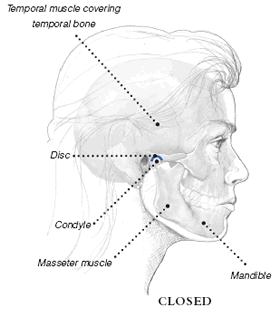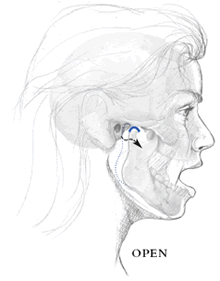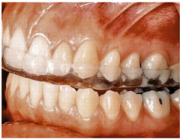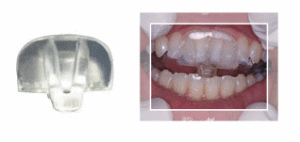TMJ poblems
The temporomandibular joint connects the lower jaw, called the mandible, to the bone at the side of the head—the temporal bone. If you place your fingers just in front of your ears and open your mouth, you can feel the joints. Because these joints are flexible, the jaw can move smoothly up and down and side to side, enabling us to talk, chew and yawn. Muscles attached to and surrounding the jaw joint control its position and movement.


When we open our mouths, the rounded ends of the lower jaw, called condyles, glide along the joint socket of the temporal bone. The condyles slide back to their original position when we close our mouths. To keep this motion smooth, a soft disc lies between the condyle and the temporal bone. This disc absorbs shocks to the jaw joint from chewing and other movements.
The temporomandibular joint is different from the body’s other joints. The combination of hinge and sliding motions makes this joint among the most complicated in the body. Also, the tissues that make up the temporomandibular joint differ from other load-bearing joints, like the knee or hip. Because of its complex movement and unique makeup, the jaw joint and its controlling muscles can pose a tremendous challenge to both patients and health care providers when problems ariseEklem bölgesinde ağrı veya eklemde fonksiyon bozukluğu olan kişilerin sayısı düşünüldüğünden çok daha fazladır.Eklemin dışındaki komşu yapılardaki değişiklikler ve sistemik hastalıklarda çeşitli klinik bulguların ortaya çıkmasına sebep olur.Bazen kaslarla ilgili bozukluk görüldüğünde ağrı ve fonksiyon kaybı görülebilir.
TMJ (Tempora Mandibular Joint)Problems
What are TMJ disorders?
Disorders of the jaw joint and chewing muscles—and how people respond to them—vary widely. Researchers generally agree that the conditions fall into three main categories:
- Myofascial pain, the most common temporomandibular disorder, involves discomfort or pain in the muscles that control jaw function.
- Internal derangement of the joint involves a displaced disc, dislocated jaw, or injury to the condyle.
- Arthritis refers to a group of degenerative/inflammatory joint disorders that can affect the temporomandibular joint.
A person may have one or more of these conditions at the same time. Some people have other health problems that co-exist with TMJ disorders, such as chronic fatigue syndrome, sleep disturbances or fibromyalgia, a painful condition that affects muscles and other soft tissues throughout the body. It is not known whether these disorders share a common cause.
People who have a rheumatic disease, such as rheumatoid arthritis, may develop TMJ disease as a secondary condition. Rheumatic diseases refer to a large group of disorders that cause pain, inflammation, and stiffness in the joints, muscles, and bone. Both rheumatoid arthritis and some TMJ disorders involve inflammation of the tissues that line the joints. The exact relationship between these conditions is not known.
How jaw joint and muscle disorders progress is not clear. Symptoms worsen and ease over time, but what causes these changes is not known. Most people have relatively mild forms of the disorder. Their symptoms improve significantly, or disappear spontaneously, within weeks or months. For others, the condition causes long-term, persistent and debilitating pain.
What are the signs and symptoms?
- ear pain
- stiffness or pain at neck
- tireness while eating
- numbness in hands
- tinnitus in ears
- radiating pain in the face, jaw, or neck,
- jaw muscle stiffness,
- limited movement or locking of the jaw,
- painful clicking, popping or grating in the jaw joint when opening or closing the mouth,
- a change in the way the upper and lower teeth fit together.
TMJ displacement or condile and7or disc degenerations may also occur.The different clinical symtoms can not always be identifieed as a disc displacement.The function and disfunction of myofacial muscles have also to be considered.
Temporamandibuler Eklem Bozukluklarına Sebep Olan Faktörler
There are many external factors that place undue strain on the TMJ. These include but are not limited to the following:
Over-opening the jaw beyond its range for the individual or unusually aggressive or repetitive sliding of the jaw sideways (laterally) or forward (protrusive). These movements may also be due to parafunctional habits or a malalignment of the jaw or dentition. This may be due to:
- Trauma
- Repetitive unconscious jaw movements called bruxing
- Malalignment of the occlusal surfaces of the teeth due to dental defect or neglect.
- Jaw thrusting (causing unusual speech and chewing habits).
- Excessive gum chewing or nail biting.
- Size of foods eaten.
- Degenerative joint disease, such as osteoarthritis or organic degeneration of the articular surfaces, recurrent fibrous and/or bony ankylosis, developmental abnormality, or pathologic lesions within the TMJ
- Myofascial pain dysfunction syndrome
- Unidentified factors
- Autoimmune diseases,rhomatoid arthritis,lupus
- Psychological disorders: stress,depression,somatisation
- Orofacial kinetic disorders
- Dental or interjaw relation abnormalities
Where do I know that I have a TMJ problem ?
- Do you hear any noises like popping,clicking when you open your mouth?
- Do you have pain in those areas: temporal region,joint,lower and/or upper jaw,neck,back of the head?
- Do you have obstruction in your ears,pressure or exessive ear pollution discharge ?
- Do you hear voices like tinging or loud thundering?
- Have you ever had any dizziness?
- Do you have shivers or numbness in your hands,fingers and arms?
- Do you easily get tired or do you think you suffer from chronic tireness?
- Do you see intentions of your teeth on the side of your tounge?
- Do you feel like your toung gets between your teeth while swallowing?
- Do you experience any difficulty in chewing?
- Have you lately lost any molar tooth?
- Do youy clench during day and/or night?
- Are you bruxing during sleep?(Ask your relatives)
- Have you ever wken up with a tooth ache?
- Have you ever had any neck injury?
- Have you ever had any trauma on your jaw,face or head?
- Do you witness that pain killers are not very affective?
- Do your symtoms get worse during chewing?
- Do you have pain when you bilaterally put your fingertips in your ear and open up your mouth?
- Does your jaw unintentionally move right or left when you open up?
- Do your first three fingers fit into your mouth when you open up?
- Do you have facial asymetry?
If the answer to most of the questions is YES you may have a TMJ problem..You have to consult your dentist.
Methods to selfdetermine your TMJ poblems
Put your fingers in your ears open up and close a couple of times and look whether you hear any clicks or poppings?
Open up your mout infront of the mirror and see whether it moves sideways and whether you have pain?
Move your lower jaw sideways and see whether it hurts?
Control your muscle sensitivity
Place your fingers exactly at the jaw location right infront of the earsd and apply pressure,if you have some disconfort or pain please visit a doctor.
 TMJ Treatment
TMJ Treatment
- Treatment of the symptoms
- Treating the underlying cause
- Treating of the predisposing factors
- Treating of the patalogies
TMJ Treatment Options
 Because more studies are needed on the safety and effectiveness of most treatments for jaw joint and muscle disorders, experts strongly recommend using the most conservative, reversible treatments possible. Conservative treatments do not invade the tissues of the face, jaw, or joint, or involve surgery. Reversible treatments do not cause permanent changes in the structure or position of the jaw or teeth. Even when TMJ disorders have become persistent, most patients still do not need aggressive types of treatment.
Because more studies are needed on the safety and effectiveness of most treatments for jaw joint and muscle disorders, experts strongly recommend using the most conservative, reversible treatments possible. Conservative treatments do not invade the tissues of the face, jaw, or joint, or involve surgery. Reversible treatments do not cause permanent changes in the structure or position of the jaw or teeth. Even when TMJ disorders have become persistent, most patients still do not need aggressive types of treatment.
Conservative Treatments
Because the most common jaw joint and muscle problems are temporary and do not get worse, simple treatment is all that is usually needed to relieve discomfort.
Self-Care Practices
There are steps you can take that may be helpful in easing symptoms, such as:
- eating soft foods,
- applying ice packs,
- avoiding extreme jaw movements (such as wide yawning, loud singing, and gum chewing),
- learning techniques for relaxing and reducing stress,
- practicing gentle jaw stretching and relaxing exercises that may help increase jaw movement. Your health care provider or a physical therapist can recommend exercises if appropriate for your particular condition.
Pain Medications
For many people with TMJ disorders, short-term use of over-the-counter pain medicines or nonsteroidal anti-inflammatory drugs (NSAIDS), such as ibuprofen, may provide temporary relief from jaw discomfort. When necessary, your dentist or doctor can prescribe stronger pain or anti-inflammatory medications, muscle relaxants, or anti-depressants to help ease symptoms.
Stabilization Splints
Your doctor or dentist may recommend an oral appliance, also called a stabilization splint or bite guard, which is a plastic guard that fits over the upper or lower teeth. Stabilization splints are the most widely used treatments for TMJ disorders. Studies of their effectiveness in providing pain relief, however, have been inconclusive. If a stabilization splint is recommended, it should be used only for a short time and should not cause permanent changes in the bite. If a splint causes or increases pain, stop using it and see your health care provider.
The conservative, reversible treatments described are useful for temporary relief of pain – they are not cures for TMJ disorders. If symptoms continue over time, come back often, or worsen, tell your doctor.
Mandibular Repositioning Devices
Can be worn for a short time to help alleviate symptoms related to painful clicking when opening the mouth wide, but 24-hour wear for the long term may lead to changes in the position of the teeth that can complicate treatment. A typical long-term permanent treatment (if the device is proven to work especially well for the situation) would be to convert the device to a flat-plane bite plate fully covering either the upper or lower teeth and to be used only at night.
Botox
Botox™ (botulinum toxin type A) is a drug made from the same bacterium that causes food poisoning. Used in small doses, Botox injections can actually help alleviate some health problems. The Food and Drug Administration (FDA) has approved Botox for the treatment of certain eye muscle disorders, cervical dystonia (neck muscle spasms), and severe underarm sweating, as well as for limited cosmetic use. Botox has not been approved by the FDA for use in TMJ disorders. Research is under way to learn how Botox specifically affects jaw muscles and their nerves. The findings will help determine if this drug may be useful in treating TMJ disorders.
Irreversible Treatments
Irreversible treatments that have not been proven to be effective – and may make the problem worse – include orthodontics to change the bite; crown and bridge work to balance the bite; grinding down teeth to bring the bite into balance, called “occlusal adjustment”; and repositioning splints, also called orthotics, which permanently alter the bite.
Surgical
Other types of treatments, such as surgical procedures, invade the tissues. Surgical treatments are controversial, often irreversible, and should be avoided where possible. There have been no long-term clinical trials to study the safety and effectiveness of surgical treatments for TMJ disorders. Nor are there standards to identify people who would most likely benefit from surgery. Failure to respond to conservative treatments, for example, does not automatically mean that surgery is necessary. If surgery is recommended, be sure to have the doctor explain to you, in words you can understand, the reason for the treatment, the risks involved, and other types of treatment that may be available.
Implants
Surgical replacement of jaw joints with artificial implants may cause severe pain and permanent jaw damage. Some of these devices may fail to function properly or may break apart in the jaw over time. If you have already had temporomandibular joint surgery, be very cautious about considering additional operations. Persons undergoing multiple surgeries on the jaw joint generally have a poor outlook for normal, pain-free joint function. Before undergoing any surgery on the jaw joint, it is extremely important to get other independent opinions and to fully understand the risks.
Manual adjustment of the bite by grinding the teeth
Reconstructive dentistry
Orthodontics
Arthrocentesis (joint irrigation)
Surgical repositoning of jaws to correct congenital jaw malformations such as prognathism and retrognathia
Replacement of the jaw joint(s) or disc(s) with TMJ implants (This should be considered only as a treatment of last resort.)
